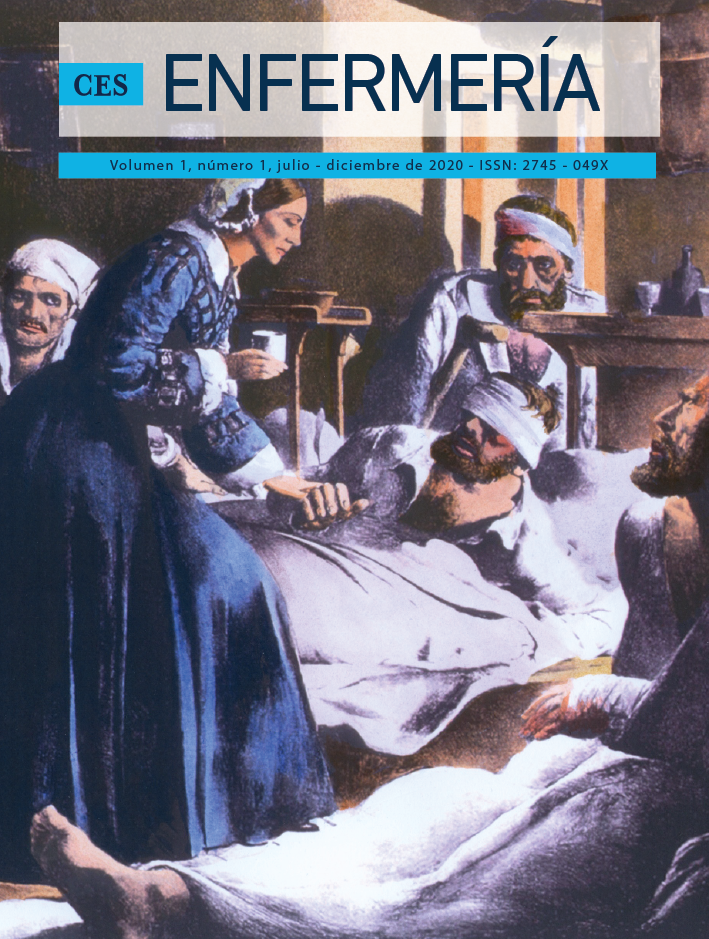Diseño y Validación de una Escala de Conocimientos sobre VIH en Población Habitante de Calle
Palabras clave:
Estudios de Validación, Conocimiento, VIH, Personas sin HogarResumen
Si bien existen instrumentos que evalúan conocimientos sobre VIH estos no son específicos para población habitantes de calle. Objetivo: Esta investigación busco ddesarrollar un cuestionario para identificar conocimientos en VIH-SIDA como una herramienta de fácil aplicación en población habitante de calle. Metodología: Se encuestaron 338 habitantes de calle mayores de 18 años. El diseño, la construcción y la validación de la escala se realizó en las siguientes etapas: 1) construcción de reactivos de la escala; 2) Evaluación de la validez de contenido a través de una revisión de expertos; 3) Aplicación del cuestionario final con una muestra de N=338 habitantes de calle utilizando muestreo de tiempo y lugar; y 4) Evaluación de consistencia interna, análisis de componentes principales y análisis factorial exploratorio (AFE) y confirmatorio (AFC). Resultados: Se encontraron dos factores: prevención y creencias erróneas, que explicaron el 52,0% de la varianza y reportaron un ajuste adecuado en el AFC, presentando niveles admisibles de ajuste a los datos La encuesta mostró adecuados valores de consistencia interna (α de Cronbach = 0,91). El 87% de la población habitante de calle tenía conocimientos con respecto a la transmisión del VIH al no utilizar condón, pero disminuye al 60% este conocimiento al consultar si el tener sexo oral puede transmitir la infección por VIH. Conclusiones: Los resultados muestran que, en general, las soluciones factoriales obtenidas son validadas usando AFC; además la escala representa un indicador confiable y válido para la evaluación de conocimientos relacionados con la prevención del VIH y las creencias erróneas en población habitante de calle.
Descargas
Referencias bibliográficas
ONUSIDA [citado 09 de agosto de 2020]. Recuperado a partir de: https://www.unaids.org/es/resources/fact-sheet
ONUSIDA. Datos fundamentales sobre el sida [Internet]. 2012. Recuperado a partir de: http://search2.unaids.org/custom/search.asp
Ministerio de Salud y Protección Social de Colombia, en Informe de resultados comportamiento sexual y prevalencia de VIH en hombres que tienen relaciones sexuales con hombres: en siete ciudades de Colombia. El Foro, Recuperado de : https://www.minsalud.gov.co/sites/rid/Lists/BibliotecaDigital/RIDE/INEC/INTOR/libro-comportamiento-sexual-hombres-2016.pdf
ONUSIDA. Marco para la vigilancia y la evaluación de los programas de prevención del VIH dirigidos a las poblaciones de mayor riesgo [Internet]. 2008 [citado 26 de agosto de 2012]. Recuperado a partir de: about:home
Bonilla R. Situación actual y prospectiva de la niñez y la juventud en Colombia [Internet]. 2012. Recuperado a partir de: http://207.58.191.15:8180/xmlui/bitstream/handle/123456789/119/doc_siju.pdf?sequence=
Ministerio de Salud. Resultado del estudio de comportamiento sexual y prevalencia de la infección por VIH prevalencia en población habitante de calle: en cuatro ciudades de Colombia. El Foro, Recuperado de: https://www.minsalud.gov.co/sites/rid/Lists/BibliotecaDigital/RIDE/INEC/INTOR/libro-comportamiento-sexual-infeccion-vih2016.pdf
Hauff AJ, Secor-Turner M. Homeless health needs: shelter and health service provider perspective. J Community Health Nurs. 2014;31(2):103-17.
Organizacion Mundial de la Salud, ONUSIDA. Guías sobre la vigilancia del VIH de segunda generacíon [Internet]. 2000. Recuperado a partir de: http://cedoc.cies.edu.ni/general/2nd_Generation%20%28D%29/Surveillance%20Guidelines/2nd%20Generation%20Surveillance/2nd%20gen%20Spa.pdf
Ministerio de la Protección Social. República de Colombia. Plan Nacional de respuesta ante el VIH y el SIDA. Colombia 2008 - 2011. 2008.
Beijer U, Wolf A, Fazel S. Prevalence of tuberculosis, hepatitis C virus, and HIV in homeless people: a systematic review and meta-analysis. Lancet Infect Dis. noviembre de 2012;12(11):859-70.
Profamilia. Conocimiento del VIH entre las mujeres y su percepción del riesgo: Encuesta Nacional de Demografía y Salud Colombia [Internet]. 2010. Recuperado a partir de: http://www.profamilia.org.co/encuestas/
Villaseñor-Sierra A, Caballero-Hoyos R, Hidalgo-San Martín A, Santos-Preciado J. Conocimiento objetivo y subjetivo sobre el VIH/SIDA como predictor del uso de condón en adolescentes. Salud Pública Méx Rev En Internet [Internet]. 2011;451. Recuperado a partir de: http://www.scielo.org.mx/scielo.php?script=sci_arttext&
Pavía-Ruz N, Góngora-Biachi R, Vera-Gamboa L, Moguel-Rodríguez W, González-Martínez P. Conocimientos, actitudes y percepción de riesgo en referencia al VIH/SIDA en población rural de Yucatán, México. Rev Biomed. 2012;23:53-60.
Vargas R. Conocimientos, actitudes y prácticas VIH/sida y uso del condón [Internet]. 2006. Recuperado a partir de: http://www.cipacdh.org/pdf/VIH%20SIDA%20CONDON%20TRAILEROS%20CIPAC.pdf
Ríos E, Ferrer L, Casabona J, Caylá J, Avecilla À, Gómez I Prat J, et al. Conocimiento sobre el VIH y las infecciones de transmisión sexual en inmigrantes latinoamericanos y magrebíes en Cataluña. Gac Sanit. noviembre de 2009;23(6):533-8.
Berbesi D, Segura-Cardona A, Caicedo B, Cardona-Arango D. Prevalencia y factores asociados al VIH en habitante de calle de la ciudad de Medellín Colombia. Fac Nac Salud Pública. 15 de mayo de 2015;33(2):200-5.
Karon JM, Wejnert C. Statistical methods for the analysis of time-location sampling data. J Urban Health Bull N Y Acad Med. junio de 2012;89(3):565-86.
Berbesi D, Agudelo A, Segura C, Montoya L. VIH en habitantes de calle de Medellín. Rev Fac Nac Salud Publica. 2012;30:310-5.
Berbesi-Fernandez D, Montoya-Vélez, Segura-Cardona. Uso del condón y conocimientos sobre prevención del VIH entre los inyectadores de drogas de dos ciudades colombianas. Adicciones. 2013;25(4):321-6.
Segura-Cardona Á, Berbesi-Fernández D, Cardona-Arango D, Ordóñez-Molina J. Construcción preliminar de un cuestionario sobre conocimientos en VIH/SIDA en excombatientes de Colombia. Rev Peru Med Exp Salud Publica. julio de 2011;28(3):503-7.
Clinical Services Policy and Planning Unit. Homelessness and Human Services – a Health Service Response. South East Health; 2000.
Metraux S. Homelessness and HIV Risk Behaviors among Injection Drug Users. J Urban Health Bull N Y Acad Med. diciembre de 2004;81(4):618-29.
Dávila ME, Tagliaferro AZ, Bullones X, Daza D. Nivel de Conocimiento de Adolescentes sobre VIH/SIDA. Rev Salud Pública. 2008;10(5):716-22.
Ugarte WJ, Högberg U, Valladares E, Essén B. Assessing knowledge, attitudes, and behaviors related to HIV and AIDS in Nicaragua: a community-level perspective. Sex Reprod Healthc Off J Swed Assoc Midwives. marzo de 2013;4(1):37-44.
Ministerio de la Protección Social. Modelo de gestión programática en VIH/sida Colombia. Disponible en: https://www.minsalud.gov.co/Documentos%20y%20Publicaciones/MODELO%20DE%20GESTION%20PROGRAMATICA%20VIH%20SIDA.pdf
Douaihy AB, Stowell KR, Bui T, Daley D, Salloum I. HIV/AIDS and homelessness, Part 1: background and barriers to care. AIDS Read. octubre de 2005;15(10):516-20, 527.
Bryan A, Schmiege SJ, Broaddus MR. Mediational analysis in HIV/AIDS research: estimating multivariate path analytic models in a structural equation modeling framework. AIDS Behav. mayo de 2007;11(3):365-83.
Russell DW. In Search of Underlying Dimensions: The Use (and Abuse) of Factor Analysis in Personality and Social Psychology Bulletin. Pers Soc Psychol Bull. 1 de diciembre de 2002;28(12):1629-46.
Sabin KM, Johnston LG. Epidemiological challenges to the assessment of HIV burdens among key populations: respondent-driven sampling, time-location sampling and demographic and health surveys. Curr Opin HIV AIDS. marzo de 2014;9(2):101-6.
Descargas
Publicado
Cómo citar
Número
Sección
| Estadísticas de artículo | |
|---|---|
| Vistas de resúmenes | |
| Vistas de PDF | |
| Descargas de PDF | |
| Vistas de HTML | |
| Otras vistas | |



